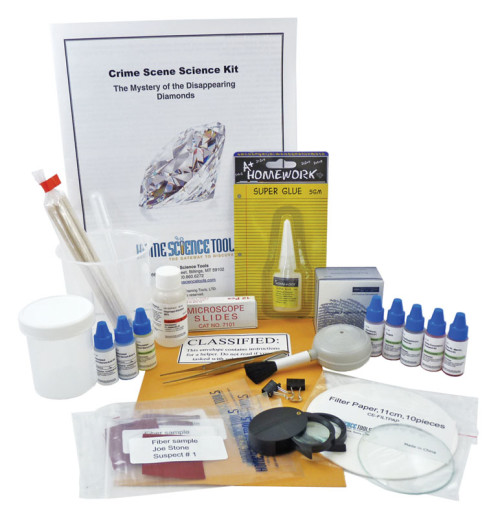We use cookies to make your experience better. To comply with the new e-Privacy directive, we need to ask for your consent to set the cookies. Learn more.
Crime Scene Science Kit
Take the study of science into the real world with this hands-on kit that applies biology and chemistry to solve a mock crime (robbery). Beginning with an introduction to forensic science, the Activity Manual provides a case to solve, seven crime scene projects, and materials to complete the tests and solve the case. The seven projects cover foundational forensic principles including fingerprinting, chromatography, blood type analysis and fiber analysis. Students will dust and fume fingerprints to identify suspects, analyze ink using chromatography, determine blood types using mock blood, and analyze fibers. Along with the Activity Manual, you receive chemical safety information, fingerprint dusting powder, black optics cleaning blower brush, plain glass slides (12), superglue, 250 ml polypropylene beaker, isopropyl alcohol (90%), filter paper, watch glass, fabric samples, synthetic blood samples, double lens magnifying glass (5x/10x), 125 ml. plastic jar, disposable pipet, wooden splints, stainless steel forceps, small binder clip, and manila envelope with classified information (instructions and solution for helper). With enough materials to perform each test more than once, there is an opportunity to create other mock crimes to be solved. A microscope (40x magnification) is recommended for one activity. Provides an excellent opportunity to introduce forensic science to children, and may inspire a future career or simply engage a student who feels there is no practical reason to study science! ~Deanne
Kids become crime scene investigators with this hands-on Crime Scene kit! Using the materials inside, students get to use real lab experiments and fingerprinting to solve the case and discover who stole the diamonds. This complete one-box evidence collection has everything kids need for authentic crime scene investigation tests, including a step-by-step manual and case file. Seven lab tests are included with this best-selling kit!
Contents list: Fingerprint Dusting Powder, black Optics Cleaning Blower Brush, Plain Glass Slides, 12 pack;Superglue (for fingerprint fuming); Beaker, polypropylene, 250 ml; Isopropyl Alcohol, 90%, 30 ml; Filter Paper, 11 cm, 10 pack (for chromatography ink tests); Watch Glass, 65 mm;Forensic Fabric Samples (for fiber analysis); Synthetic Blood Samples (for simulated blood test); Magnifying Glass, double lens, 5x/10x; Jar, 125 ml (4 oz), plastic; Pipet, disposable, 1 ml; Wooden Splints, 20 pack; Forceps, stainless steel; Small Binder Clip; Manila Envelope, 6""x9"; Complete Activity/Case Manual
| Product Format: | Other |
|---|---|
| Brand: | Home Science Tools |
| Grades: | 6-12 |
| Length in Inches: | 4.625 |
| Width in Inches: | 10.25 |
| Height in Inches: | 11.9375 |
| Weight in Pounds: | 1.55 |

